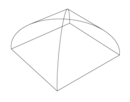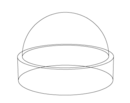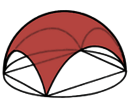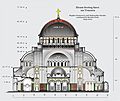Dome facts for kids
A dome is a feature of architecture that usually looks like the upper half of a sphere on top of a building.
It is a feature that makes many religious and government buildings stand out, because if someone is speaking to others inside or under a dome, the voice sounds louder. Also a dome makes it easier to identify an important building, for example a temple or a palace.
A large stadium with a roof over the playing field is often called a "dome". One example of that usage is the Metrodome.
-
St. Peter's basilica in Vatican City, with a dome, seen from outside.
-
Gilded onion domes of the Cathedral of the Annunciation, Moscow Kremlin
-
Fiberglass dome cottage in Davis, California
Contents
General types
Beehive dome
Also called a corbelled dome, or false dome, these are different from a 'true dome' in that they consist of purely horizontal layers. As the layers get higher, each is slightly cantilevered, or corbeled, toward the center until meeting at the top. A monumental example is the Mycenaean Treasury of Atreus from the late Bronze Age.
Braced dome
A single layer space frame in the form of a dome, a braced dome is a generic term that includes ribbed, Schwedler, three-way grid, lamella or Kiewitt, lattice, and geodesic domes. The different terms reflect different arrangements in the surface members. Braced domes often have a very low weight and are usually used to cover spans of up to 150 meters.
Cloister vault
Called domical vaults (a term sometimes also applied to sail vaults), polygonal domes, coved domes, gored domes, segmental domes (a term sometimes also used for saucer domes), paneled vaults, or pavilion vaults, these are domes that maintain a polygonal shape in their horizontal cross section. The earliest known examples date to the first century BC, such as the Tabularium of Rome from 78 BC. Others include the Baths of Antoninus in Carthage (145–160) and the Palatine Chapel at Aachen (13th – 14th century). The most famous example is the Renaissance octagonal dome of Filippo Brunelleschi over the Florence Cathedral. Thomas Jefferson, the third president of the United States, installed an octagonal dome above the West front of his plantation house, Monticello.
Compound dome
Also called domes on pendentives or pendentive domes (a term also applied to sail vaults), compound domes have pendentives that support a smaller diameter dome immediately above them, as in the Hagia Sophia, or a drum and dome, as in many Renaissance and post-Renaissance domes, with both forms resulting in greater height.
Crossed-arch dome
One of the earliest types of ribbed vault, the first known examples are found in the Great Mosque of Córdoba in the 10th century. Rather than meeting in the center of the dome, the ribs characteristically intersect one another off-center, forming an empty polygonal space in the center. Geometry is a key element of the designs, with the octagon being perhaps the most popular shape used. Whether the arches are structural or purely decorative remains a matter of debate. The type may have an eastern origin, although the issue is also unsettled. Examples are found in Spain, North Africa, Armenia, Iran, France, and Italy.
Geodesic dome
Geodesic domes are the upper portion of geodesic spheres. They are composed of a framework of triangles in a polyhedron pattern. The structures are named for geodesics and are based upon geometric shapes such as icosahedrons, octahedrons or tetrahedrons. Such domes can be created using a limited number of simple elements and joints and efficiently resolve a domes internal forces. Their efficiency is said to increase with size. Although not first invented by Buckminster Fuller, they are associated with him because he designed many geodesic domes and patented them in the United States.
Hemispherical dome
The hemispherical dome is half of a sphere. According to E. Baldwin Smith, it was a shape likely known to the Assyrians, defined by Greek theoretical mathematicians, and standardized by Roman builders.
Onion dome
Bulbous domes bulge out beyond their base diameters, offering a profile greater than a hemisphere. An onion dome is a greater than hemispherical dome with a pointed top in an ogee profile. They are found in the Near East, Middle East, Persia, and India and may not have had a single point of origin. Their appearance in northern Russian architecture predates the Tatar occupation of Russia and so is not easily explained as the result of that influence. They became popular in the second half of the 15th century in the Low Countries of Northern Europe, possibly inspired by the finials of minarets in Egypt and Syria, and developed in the 16th and 17th centuries in the Netherlands before spreading to Germany, becoming a popular element of the baroque architecture of Central Europe. German bulbous domes were also influenced by Russian and Eastern European domes. The examples found in various European architectural styles are typically wooden. Examples include Kazan Church in Kolomenskoye and the Brighton Pavilion by John Nash. In Islamic architecture, they are typically made of masonry, rather than timber, with the thick and heavy bulging portion serving to buttress against the tendency of masonry domes to spread at their bases. The Taj Mahal is a famous example.
Oval dome
An oval dome is a dome of oval shape in plan, profile, or both. The term comes from the Latin ovum, meaning "egg". The earliest oval domes were used by convenience in corbelled stone huts as rounded but geometrically undefined coverings, and the first examples in Asia Minor date to around 4000 B.C. The geometry was eventually defined using combinations of circular arcs, transitioning at points of tangency. If the Romans created oval domes, it was only in exceptional circumstances. The Roman foundations of the oval plan Church of St. Gereon in Cologne point to a possible example. Domes in the Middle Ages also tended to be circular, though the church of Santo Tomás de las Ollas in Spain has an oval dome over its oval plan. Other examples of medieval oval domes can be found covering rectangular bays in churches. Oval plan churches became a type in the Renaissance and popular in the Baroque style. The dome built for the basilica of Vicoforte by Francesco Gallo was one of the largest and most complex ever made.
Parabolic dome
A parabolic dome is a unique structure in which bending stress due to the uniformly distributed load of its dead load is zero. Hence it was widely used in buildings in ancient times, before the advent of composite structures. However, if a point load is applied on the apex of a parabolic dome, the bending stress becomes infinite. Hence it is found in most ancient structures, the apex of the dome is stiffened or the shape modified to avoid the infinite stress.
Sail dome
Also called sail vaults, handkerchief vaults, domical vaults (a term sometimes also applied to cloister vaults), pendentive domes (a term that has also been applied to compound domes), Bohemian vaults, or Byzantine domes, this type can be thought of as pendentives that, rather than merely touching each other to form a circular base for a drum or compound dome, smoothly continue their curvature to form the dome itself. The dome gives the impression of a square sail pinned down at each corner and billowing upward. These can also be thought of as saucer domes upon pendentives.
Saucer dome
Also called segmental domes (a term sometimes also used for cloister vaults), or calottes, these have profiles of less than half a circle. Because they reduce the portion of the dome in tension, these domes are strong but have increased radial thrust. Many of the largest existing domes are of this shape.
Masonry saucer domes, because they exist entirely in compression, can be built much thinner than other dome shapes without becoming unstable. The trade-off between the proportionately increased horizontal thrust at their abutments and their decreased weight and quantity of materials may make them more economical, but they are more vulnerable to damage from movement in their supports.
Umbrella dome
Also called gadrooned, fluted, organ-piped, pumpkin, melon, ribbed, parachute, scalloped, or lobed domes, these are a type of dome divided at the base into curved segments, which follow the curve of the elevation. "Fluted" may refer specifically to this pattern as an external feature, such as was common in Mamluk Egypt. The "ribs" of a dome are the radial lines of masonry that extend from the crown down to the springing. The central dome of the Hagia Sophia uses the ribbed method, which accommodates a ring of windows between the ribs at the base of the dome. The central dome of St. Peter's Basilica also uses this method.
Images for kids
-
Comparison of a generic "true" arch (left) and a corbel arch (right)
-
Painting by Giovanni Paolo Pannini of the Pantheon in Rome.
-
Originally a church, Hagia Sophia (532–537) by Byzantine emperor Justinian the Great was the largest cathedral in the world for nearly a thousand years.
-
The Dome of the Rock in Jerusalem
-
Saint Basil's Cathedral (1555–61) in Moscow, Russia. Its distinctive onion domes date to the 1680s.
-
Blue Mosque in Istanbul, a World Heritage Site and example of the classical style period of Ottoman architecture, showing Byzantine influence.
-
The Cathedral of Florence with Brunelleschi's dome, Italy
-
The Taj Mahal in Agra, India built by Shah Jahan.
-
Central Dome of Tajhat Palace, Rangpur, Bangladesh
-
The dome of St Paul's Cathedral in London
-
Geodesic domes of the Eden Project in United Kingdom
See also
 In Spanish: Cúpula para niños
In Spanish: Cúpula para niños































